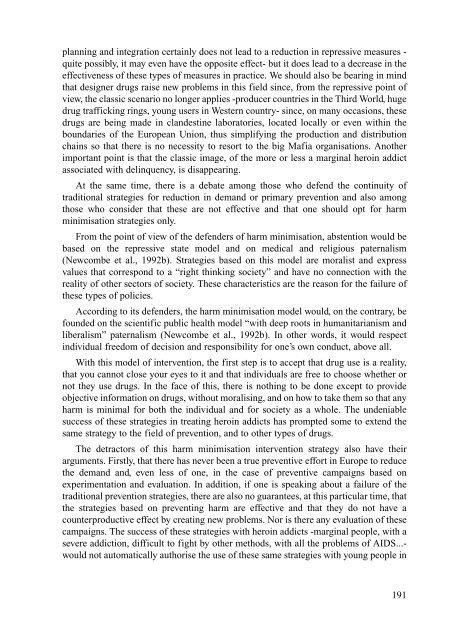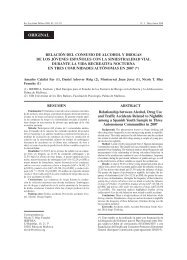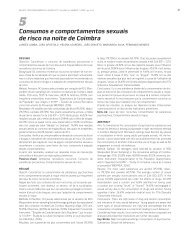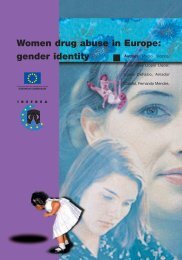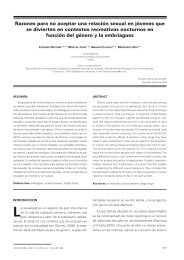Characteristics and social representation of ecstasy in Europe - Irefrea
Characteristics and social representation of ecstasy in Europe - Irefrea
Characteristics and social representation of ecstasy in Europe - Irefrea
You also want an ePaper? Increase the reach of your titles
YUMPU automatically turns print PDFs into web optimized ePapers that Google loves.
plann<strong>in</strong>g <strong>and</strong> <strong>in</strong>tegration certa<strong>in</strong>ly does not lead to a reduction <strong>in</strong> repressive measures -quite possibly, it may even have the opposite effect- but it does lead to a decrease <strong>in</strong> theeffectiveness <strong>of</strong> these types <strong>of</strong> measures <strong>in</strong> practice. We should also be bear<strong>in</strong>g <strong>in</strong> m<strong>in</strong>dthat designer drugs raise new problems <strong>in</strong> this field s<strong>in</strong>ce, from the repressive po<strong>in</strong>t <strong>of</strong>view, the classic scenario no longer applies -producer countries <strong>in</strong> the Third World, hugedrug traffick<strong>in</strong>g r<strong>in</strong>gs, young users <strong>in</strong> Western country- s<strong>in</strong>ce, on many occasions, thesedrugs are be<strong>in</strong>g made <strong>in</strong> cl<strong>and</strong>est<strong>in</strong>e laboratories, located locally or even with<strong>in</strong> theboundaries <strong>of</strong> the <strong>Europe</strong>an Union, thus simplify<strong>in</strong>g the production <strong>and</strong> distributioncha<strong>in</strong>s so that there is no necessity to resort to the big Mafia organisations. Anotherimportant po<strong>in</strong>t is that the classic image, <strong>of</strong> the more or less a marg<strong>in</strong>al hero<strong>in</strong> addictassociated with del<strong>in</strong>quency, is disappear<strong>in</strong>g.At the same time, there is a debate among those who defend the cont<strong>in</strong>uity <strong>of</strong>traditional strategies for reduction <strong>in</strong> dem<strong>and</strong> or primary prevention <strong>and</strong> also amongthose who consider that these are not effective <strong>and</strong> that one should opt for harmm<strong>in</strong>imisation strategies only.From the po<strong>in</strong>t <strong>of</strong> view <strong>of</strong> the defenders <strong>of</strong> harm m<strong>in</strong>imisation, abstention would bebased on the repressive state model <strong>and</strong> on medical <strong>and</strong> religious paternalism(Newcombe et al., 1992b). Strategies based on this model are moralist <strong>and</strong> expressvalues that correspond to a “right th<strong>in</strong>k<strong>in</strong>g society” <strong>and</strong> have no connection with thereality <strong>of</strong> other sectors <strong>of</strong> society. These characteristics are the reason for the failure <strong>of</strong>these types <strong>of</strong> policies.Accord<strong>in</strong>g to its defenders, the harm m<strong>in</strong>imisation model would, on the contrary, befounded on the scientific public health model “with deep roots <strong>in</strong> humanitarianism <strong>and</strong>liberalism” paternalism (Newcombe et al., 1992b). In other words, it would respect<strong>in</strong>dividual freedom <strong>of</strong> decision <strong>and</strong> responsibility for one’s own conduct, above all.With this model <strong>of</strong> <strong>in</strong>tervention, the first step is to accept that drug use is a reality,that you cannot close your eyes to it <strong>and</strong> that <strong>in</strong>dividuals are free to choose whether ornot they use drugs. In the face <strong>of</strong> this, there is noth<strong>in</strong>g to be done except to provideobjective <strong>in</strong>formation on drugs, without moralis<strong>in</strong>g, <strong>and</strong> on how to take them so that anyharm is m<strong>in</strong>imal for both the <strong>in</strong>dividual <strong>and</strong> for society as a whole. The undeniablesuccess <strong>of</strong> these strategies <strong>in</strong> treat<strong>in</strong>g hero<strong>in</strong> addicts has prompted some to extend thesame strategy to the field <strong>of</strong> prevention, <strong>and</strong> to other types <strong>of</strong> drugs.The detractors <strong>of</strong> this harm m<strong>in</strong>imisation <strong>in</strong>tervention strategy also have theirarguments. Firstly, that there has never been a true preventive effort <strong>in</strong> <strong>Europe</strong> to reducethe dem<strong>and</strong> <strong>and</strong>, even less <strong>of</strong> one, <strong>in</strong> the case <strong>of</strong> preventive campaigns based onexperimentation <strong>and</strong> evaluation. In addition, if one is speak<strong>in</strong>g about a failure <strong>of</strong> thetraditional prevention strategies, there are also no guarantees, at this particular time, thatthe strategies based on prevent<strong>in</strong>g harm are effective <strong>and</strong> that they do not have acounterproductive effect by creat<strong>in</strong>g new problems. Nor is there any evaluation <strong>of</strong> thesecampaigns. The success <strong>of</strong> these strategies with hero<strong>in</strong> addicts -marg<strong>in</strong>al people, with asevere addiction, difficult to fight by other methods, with all the problems <strong>of</strong> AIDS...-would not automatically authorise the use <strong>of</strong> these same strategies with young people <strong>in</strong>191


